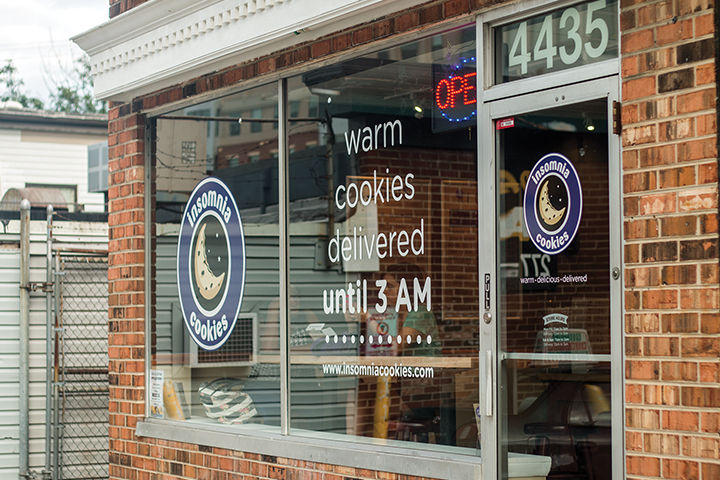
Insomnia Cookies opened on Route 1 August 10.
The City Council unanimously approved College Park’s 2015-2020 Strategic Plan at its Aug. 11 meeting, outlining goals for strengthening community-university ties and heightening environmental protection.
The plan includes six goals: creating “One College Park” of diverse and united populations, promoting environmental sustainability, engaging in high-quality development and reinvestment, building quality infrastructure, fostering effective city leadership and ensuring excellent city services.
“We are very excited to have passed this,” Mayor Andy Fellows said. “It lays out some good goals for the city. … [The city and its residents] share so many things in common in terms of self-interest for the quality of life in College Park and making College Park a great place to live, work and play.”
District 1 Councilman Patrick Wojahn said the city hired The Novak Consulting Group in December to assist with developing the plan. City residents and other stakeholders held meetings over an eight-month period to discuss the strategic plan and frame its priorities.
An online survey also helped determine the opportunities and issues residents wanted to see addressed in the future, and an environmental scan published in February offered age and demographic statistics on the city’s population.
The plan follows up on some of the goals laid out in the 2010-2015 Strategic Plan, District 1 Councilman Fazlul Kabir said, but also includes fresh ideas, like the “One College Park” concept, which he, Wojahn and Fellows agreed is one of the plan’s most important points.
“We have a lot of different demographics, and I think it is a challenge in front of us to close the gap between them,” Kabir said.
For example, Wojahn said he would like to see more engagement with the city’s growing Hispanic population, which rose from 5.5 percent in 2000 to about 10 percent in 2013, according to The Novak Consulting Group’s report. He said he hopes creating a city communications position, which the plan recommends, could lead to new strategies to bolster city-resident interactions.
Council members also agreed that it’s important to continue building a strong relationship between the university and the greater College Park community.
Kabir said the campus community holds an interest in seeing the city thrive and has been instrumental in certain improvement efforts, such as revitalizing Route 1 businesses. He said he hopes to see those efforts continue.
The plan states that the city will again team up with the university’s Partnership for Active Learning in Sustainability, through which students and faculty provide local governments with low-cost problem-solving geared toward a jurisdiction’s unique issues. In May, students in a public art and design class installed temporary artwork around the city.
Another important ongoing issue is sustainability, Wojahn said, and the city plans to plant new trees, promote a community garden and generate more renewable energy.
“We will be entering a new phase in our work in making the city more sustainable,” Wojahn said. “We also want to help our residents be more sustainable with things like expanding our bicycle and pedestrian infrastructure.”
Aside from the sustainability initiative, the plan also calls for regular meetings with university officials to discuss strategies for the innovation district, an anticipated mix of apartments, university housing, offices, retail and labs along Route 1 near Ritchie Coliseum.
“We have a historic opportunity to really make sure that we become a high-class college town,” Wojahn said. “It’s important for us to make sure we work together closely to make sure the people who have a stake in the future of College Park have a say in how it’s governed.”
District 4 Councilwoman Denise Mitchell said she is excited about the strategic plan’s focus on reconstructing Route 1 as well.
“We want to make sure it’s conducive for traffic flow and for our residents to be able to travel to and from the city,” Mitchell said.
The strategic plan’s corresponding action plan, also approved Aug. 11, details how the city can accomplish each goal. “One College Park” action items, for example, include building on existing community events such as Maryland Day, College Park Day and National Night Out and partnering with local organizations to sponsor additional community engagement events.
Now that the plan has been approved, Fellows said, city staff and the council will start to look at some of the action items they intend to start tackling this fall before the November local elections. While the plan provides a good road map of how the city can progress in coming years, he said, the challenge now is making it a reality.
Mitchell said it’s important to keep residents involved in the process as the plan takes shape. She said she would like to see the council work with civic leaders in different districts and perhaps hold a citywide session to talk about the plan with residents.
Robert Day, District 3 councilman and former president of a city civic association, said he was happy so many stakeholder and resident voices were taken into account as the plan was being developed. He said the plan is an accurate reflection of what residents want to see in the city.
“I think it reaches the heart of what we want to see moving forward,” Day said. “It’s about coming together, working together and trying to build a better College Park, and I think that’s the real goal.”



